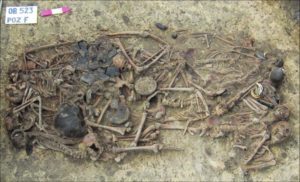
PROCEEDINGS OF THE NATIONAL ACADEMY OF SCIENCES—Researchers present evidence of Neolithic kinship and violence based on remains from a mass grave in Poland. The Bronze Age began in the third millennium BCE. The Globular Amphora culture existed during this time in Europe, but little is known about their relations with the neighboring Corded Ware culture. Hannes Schroeder, Niels N. Johannsen, Morten E. Allentoft, and colleagues sequenced the genomes of 15 individuals found in a mass grave excavated in Koszyce, Poland, that dates to approximately 2880-2776 BCE. Analyses revealed that the individuals were part of an extended family, with most of the remains belonging to mothers and children. The authors found that mothers were placed next to their children, and siblings were placed next to each other within the grave. Older males and fathers appeared to be missing from the grave. All bodies exhibited injuries and cranial fractures that likely occurred around the time of death, suggesting death by blows to the head. None of the individuals from the Globular Amphora culture shared DNA with their Corded Ware neighbors, and the authors suggest that the massacre may have been tied to the expansion of the Corded Ware groups. The findings suggest that the family’s older men may have been absent during the massacre and may have buried the bodies. According to the authors, the study* supports the notion that Neolithic violence was a common response to population pressure and competition for resources.
___________________________

The Late Neolithic mass grave at Koszyce, Poland. Piotr Wodarczak
___________________________
*”Unraveling ancestry, kinship, and violence in a Late Neolithic mass grave,” by Hannes Schroeder et al.
Article Source: A PNAS news release





One comment on “Kinship and violence in Neolithic Poland”